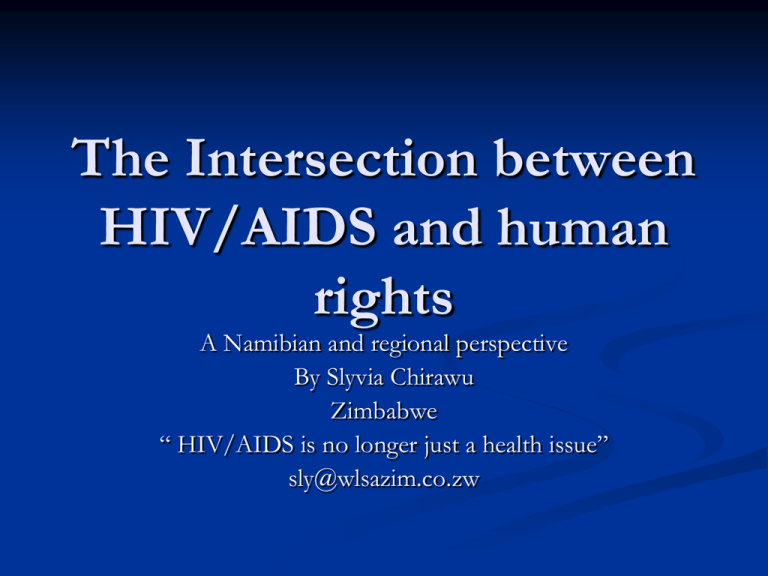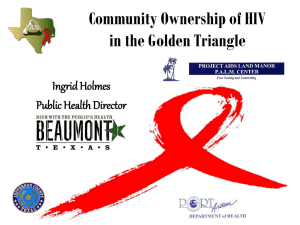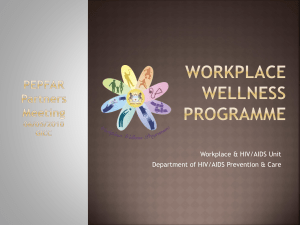
The Intersection between
HIV/AIDS and human
rights
A Namibian and regional perspective
By Slyvia Chirawu
Zimbabwe
“ HIV/AIDS is no longer just a health issue”
sly@wlsazim.co.zw
What are human rights ?
Human rights must be understood as those rights
which every individual is entitled to by virtue of being
human.
Human rights are independent of acts of law
Examples include the right to life, personal liberty,
protection from inhuman treatment, protection from
discrimination, freedom of expression, assembly and
association
Early approaches to HIV/AIDS defined it as a health
science problem-paradigm shift- health is more than the
absence of disease and infirmity but the complete
physical , mental and social wellbeing
Relationship between HIV/AIDS
and human rights
Correlation between HIV/AIDS and human rights is found in a number of international and
regional instruments which include:
International covenant on civil and political rights
International covenant on economic , social and cultural rights
CEDAW
Convention on the rights of the child
Convention against torture
African charter on human and people’s rights
Optional protocol to the African charter on human and people’s rights on the rights of women in
Africa
Millennium development goals
Abuja declaration
SADC gender declaration and its addendum
SADC HIV/AIDS strategic framework and plan of action 2003-2007
The Maseru declaration
Beijing platform for action
ICPD
The UN guidelines on HIV/AIDS
The human rights standards and
HIV/AIDS
Some of the standards related to human rights and HIV/AIDS include:
Right to non-discrimination and equal protection before the law- people living with
HIV should not face discrimination in all spheres of life
Liberty and security- so as not to be isolated and put in quarantine or segregated in any
form
Right to life- regardless of one’s status everyone has a right to live
Right to privacy- protection against mandatory testing and confidentiality
Freedom of association and assembly- no denial of admission to organizations or
places because of HIV status
Right to seek and be given information on HIV/AIDS
Right to work – right to be recruited and not fired due to one’s status
Right to health- access to treatment, health care and prevention
Right to education- no denial of access to education because of HIV status
THE REALITY IS THAT PEOPLE LIVING WITH HIV/AIDS SUFFER
DISCRIMINATION AND ARE NOT ENJOYING THEIR HUMAN RIGHTS
HIV/AIDS in SADC
Namibia lies in sub Saharan Africa which is the
epicentre of HIV/AIDS
23 million adults are infected and 57% are
women – disproportionate effect on women
SADC has the four countries worst affectedBotswana, Zimbabwe, South Africa, Swaziland
First AIDS case in Namibia – 1986
Estimated 22.5% of adult population infected
HIV/AIDS and Human rights in
Namibia and the region
The situation in Namibia mirrors that of the challenges faced in the region on
HIV/AIDS and human rights
A mixture of Law, Civil law, Roman Dutch and Customary law
Legal pluralism pose challenges in addressing HIV/AIDS
•
Lack of specific HIV/AIDS treaties within the international legal system –
more by inference
•
Namibia one of the few SADC countries where treaties are self executing- In
Zimbabwe international instruments have to be ratified by Parliament AND
domesticated to have any effect
•
Some countries have HIV/AIDS policies e.g. Botswana, Swaziland, Zambia
and Zimbabwe but some policies have no reference to human rights . Policies
related to HIV/AIDS – e.g. Namibia- Guidelines to the clinical management
of HIV/AIDS, University of Namibia HIV/AIDS policy, short term plan for
the prevention and control of HIV/AIDS – policies not reduced to
legislation
continued
Litigation confined to HIV in the workplace e.g.
Nanditume vs. Minister of Defence – Namibia ,
Zimbabwe SI 202/98 – outlaws discrimination in the
workplace on the basis of HIV/AIDS
HIV/AIDS legislation is confined to criminal law –
criminalization of wilful transmission and marital rape –
harsh penalties for wilful transmission of HIV/AIDS
Lack of specific reference to HIV/AIDS in
constitutions e.g. equality and non discrimination
clause in Namibia’s constitution. In Zimbabwe all are
equal before the law but this is different in practice .
Interpretation is left to the courts
continued
No social welfare and security for PLWA- Namibia – social assistance in
terms of a disability grant – Same for South Africa
Right to health – South African Constitution but not Namibia, Zimbabwe.
No access to ARVs and they are out of reach for many
Zimbabwe declared HIV/AIDS a state of emergency and pharmaceutical
companies can produce generic ARVs.
3 by 5 campaign not making headway
No PEP in the law but in policies
continued
HIV/AIDS not notifiable in terms of Public health
legislation
Existence of cultural practices that fuel the spread of
HIV/AIDS – wife inheritance, forced intercourse,
virginity testing, early marriage, pledging of young girls,
initiation sex, polygamy- women worst affected
Other gender based discrimination exists in domestic
violence- no legislation to deal with domestic violence
continued
Homosexuality illegal except in South Africa
LGBT community faces discrimination e.g.
Zimbabwe – GALZ
Lesbians suffer double jeopardy- totally ignored
Prostitution is illegal – sex workers mostly
women suffer discrimination
Prisoners face discrimination
Continued
Confidentiality not protected by constitutions but other
legislation e.g. in Zimbabwe – Medical practitioners
regulations protect confidentiality but are not
HIV/AIDS specific
Shared confidentiality in policies but not legislation and
efficacy of shared confidentiality not tested
ABCD strategy has failed
Poverty in the SADC countries fuels the epidemic
Why we need a human rights based
approach to fight HIV/AIDS
The situation in Namibia and the region paints a
grave situation of HIV and human rights. There
is a clear need to use the rights based approach.
HIV/AIDS affects everyone . It is not a matter
of affected and infected.
Too much discretion has been left to policy
makers to set out the needs of the infected and
affected.
Continued
Human rights framework provides a “ check list” of all
areas one needs to focus on in order to prevent the
further spread of HIV , to provide treatment to people
suffering from AIDS and to protect their place in
society
Human rights standards make law and policy makers
accountable for their actions
Human rights standards enable advocacy groups to
monitor and evaluate the extent to which the state is
fulfilling its obligations
continued
HIV/AIDS needs to be moved into the domain of demands so
that the needs can be located in rights that can be demanded by
those infected and affected
A rights based approach means locating the needs of those
infected an affected by HIV /AIDS in human rights that can be
claimed and asserted whatever views maybe expressed by the
government or community
Human rights entail the identification of mechanisms in existing
laws and policies to deal with shortcomings and limitations
Strength of the human rights based approach is that its primary
tool in the fight against HIV/AIDS is something that is inherent
in all individuals and belonging to all individuals – human rights
Suggestions for reform
Adoption of appropriate legislative , budgetary and judicial reforms to fight
HIV/AIDS e.g. HIV/specific legislation on discrimination, decriminalizing
commercial sex work
Human rights framework to be included in all policies
Development of specific policies on issues such as VCT, prisoners
Policies and strategic frameworks should have M and E in built in them
Social assistance to vulnerable groups- orphans, women and children
Political will
MDGs- poverty
Multisectoral approach
Domestication of international law instruments
Outlawing customary practices that fuel the pandemic
Improve and enhance protection of women e.g. inheritance law, domestic
violence legislation
Provision of generic drugs





